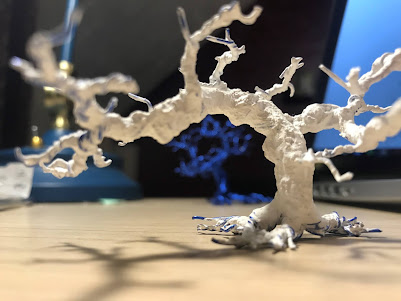HOW THE PRINTS WERE BUILT UP
I almost always tend to begin with the object I intend to use as a main subject/focal point, whilst this object may change its a good place to start things off I find. So here are the two drawings I did to be used as focal points in the prints I made. This rule stays the same if I am using photography as the predominant media too, as opposed to a drawing.
The print of the woman in a field is an example of the focal point changing, I uploaded my original drawing and began printing it off on a printer then quickly and roughly adding in a possible background. I realised after having done this that it was the figure I wasn't happy with as I felt the sleeves were to unbelievable no matter how I drew them and that it took up too much space in my frame, so I reversed and redrew the figure. (Pictures go right to left)
Once happy with the baseline drawing, I upload it and put a suggestive frame around it on Photoshop. Now I print these off and start lightly and quickly drawing in the backgrounds that I want linked to the foreground through the poem used, I will maybe do 5-10 of these and pick elements I like from each.
Now, with a stable idea to go ahead with I begin making drawings and filling in details. For this step I like to use tracing paper as I would when building up a screen print as it gives me a clear image of what the key block will look like with each line added and if a mistake is made on a single image, it is probably just that one section of drawing that needs redrawn as opposed to the entire layer/opaque that needs remade as is shown across the next images...
In the case of the Kanji character I use, which is inspired by the kanji for 'love' as is in the poem, I must have drawn around about 40 of these before happy with one. The use of tracing paper allowed me to go over the sections of each previous sketched example that I liked and change the areas I didn't.
The same applies here the water wasn't something I was confident in drawing and so being able to use small pieces of a transparency instead of printing a new blank sheet off each time saved money and time, the environment too probably. However...
It isn't always as simple s I'd like it to be, the water ripples ended up causing me so much problems that I went back to trying to directly mark it on the printed sheet, hoping for extra clarity. I'm not sure that this is what helped but after multiple attempts I had one I was happy-ish with (on the right). The main issue here I think was that there wasn't enough examples of such rippling in water to draw from wherever I looked and so it was always going to be a bit of an uphill battle. I have always been better at draughting when I have good reference to work from.
This is pretty much all that's done on paper, the colour blocks I usually try and work out digitally after quickly colouring a couple of printed examples by hand and then jump straight in to cutting the blocks.





































